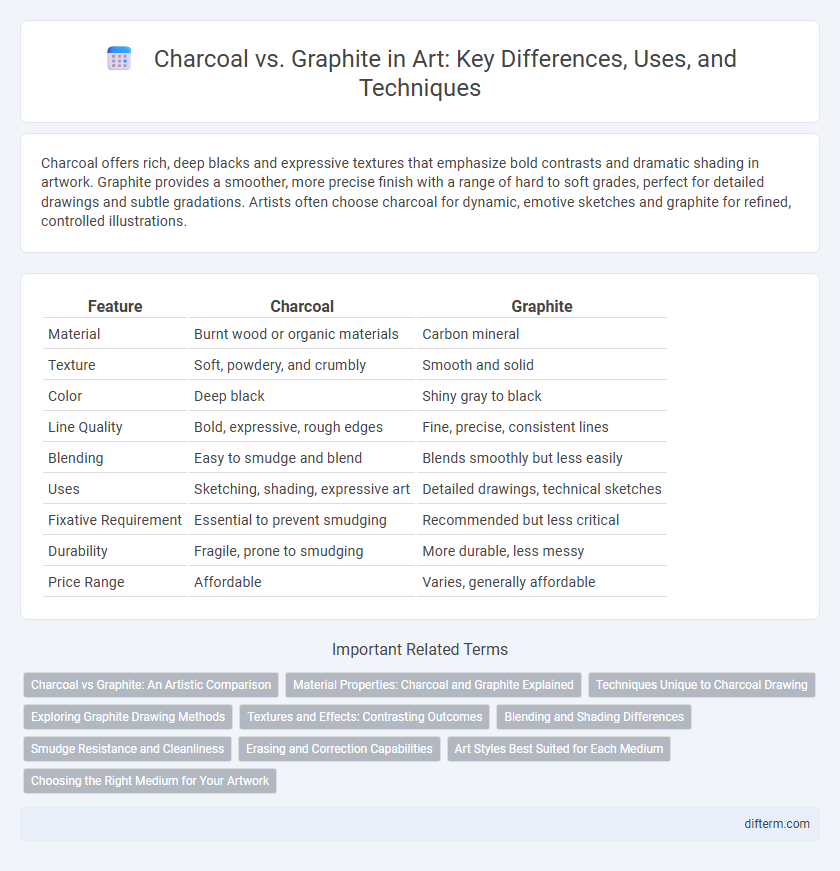Charcoal offers rich, deep blacks and expressive textures that emphasize bold contrasts and dramatic shading in artwork. Graphite provides a smoother, more precise finish with a range of hard to soft grades, perfect for detailed drawings and subtle gradations. Artists often choose charcoal for dynamic, emotive sketches and graphite for refined, controlled illustrations.
Table of Comparison
| Feature | Charcoal | Graphite |
|---|---|---|
| Material | Burnt wood or organic materials | Carbon mineral |
| Texture | Soft, powdery, and crumbly | Smooth and solid |
| Color | Deep black | Shiny gray to black |
| Line Quality | Bold, expressive, rough edges | Fine, precise, consistent lines |
| Blending | Easy to smudge and blend | Blends smoothly but less easily |
| Uses | Sketching, shading, expressive art | Detailed drawings, technical sketches |
| Fixative Requirement | Essential to prevent smudging | Recommended but less critical |
| Durability | Fragile, prone to smudging | More durable, less messy |
| Price Range | Affordable | Varies, generally affordable |
Charcoal vs Graphite: An Artistic Comparison
Charcoal offers rich, deep blacks and a textured, expressive quality ideal for bold, dramatic artwork, while graphite provides smooth, precise lines with a glossy finish suitable for detailed sketching and fine shading. Charcoal's particulate nature allows for easy smudging and blending, creating dynamic tonal variations often favored in life drawing and expressive compositions. Graphite's hardness grades, ranging from 9H (hard) to 9B (soft), enable artists to achieve subtle gradients and sharp contours, enhancing realism in portraiture and technical illustrations.
Material Properties: Charcoal and Graphite Explained
Charcoal consists of carbonized wood and offers a rich, matte black tone with a rough texture, making it ideal for expressive, bold strokes and deep shading in artworks. Graphite, a crystalline form of carbon, provides a smooth, consistent mark with varying hardness levels, allowing artists precise control from light sketches to dark, glossy lines. The porous nature of charcoal causes it to smudge easily, whereas graphite's metallic sheen resists smudging but can reflect light, influencing the artwork's visual finish.
Techniques Unique to Charcoal Drawing
Charcoal drawing techniques emphasize blending, smudging, and erasing to create rich textures and deep shadows that are difficult to achieve with graphite. Artists utilize charcoal's softness for expressive, bold strokes and its powdery consistency for smooth gradients and atmospheric effects. The medium's ability to be easily manipulated allows for dynamic contrasts and the creation of dramatic chiaroscuro in artworks.
Exploring Graphite Drawing Methods
Graphite drawing methods offer a versatile range of techniques for artists, including hatching, cross-hatching, and blending to achieve various textures and tonal values. Unlike charcoal, graphite provides a smoother application and allows for precise detail work with tools such as mechanical pencils and graphite sticks. Layering and burnishing techniques further enhance depth and contrast, making graphite ideal for realistic and refined drawings.
Textures and Effects: Contrasting Outcomes
Charcoal produces rich, deep blacks with a rough, gritty texture ideal for expressive, dramatic shading and bold contrasts. Graphite offers smooth, precise lines and a reflective sheen, enabling subtle gradations and fine detail work. The contrasting effects of charcoal's coarse marks versus graphite's polished finish create diverse textures that significantly influence the mood and depth of artwork.
Blending and Shading Differences
Charcoal offers a rich, velvety texture that blends smoothly, creating deep, dramatic shadows ideal for expressive shading. Graphite provides a finer, more controlled application with a subtle sheen, allowing precise gradation and delicate tonal variations. The choice between charcoal and graphite impacts the ease of blending, with charcoal favoring softer transitions and graphite excelling in detailed shading.
Smudge Resistance and Cleanliness
Charcoal creates bold, textured lines but smudges easily, requiring frequent fixatives to maintain clarity and prevent mess. Graphite offers smoother shading with greater smudge resistance, resulting in cleaner artwork and less cleanup. Artists favor graphite for detailed work due to its controlled application and minimal smearing.
Erasing and Correction Capabilities
Charcoal offers superior erasing and correction capabilities due to its powdery texture, allowing artists to lift marks easily with kneaded erasers for subtle tonal adjustments. Graphite, being waxier and more adhesive, is less forgiving; erased areas often retain a slight sheen or color change, limiting the potential for flawless corrections. Mastery of these mediums depends on understanding their erasing properties, influencing choices in sketching, shading, and detailed work.
Art Styles Best Suited for Each Medium
Charcoal excels in creating bold, expressive, and textured artworks ideal for gestural drawing, life studies, and chiaroscuro effects, commonly used in expressionism and realism. Graphite offers precision and smooth shading, making it perfect for detailed portraiture, architectural sketches, and hyper-realistic drawings. Both mediums cater to different art styles: charcoal suits dynamic, rough, and dramatic compositions, while graphite supports refined, controlled, and delicate renderings.
Choosing the Right Medium for Your Artwork
Charcoal offers rich, deep blacks and a textured finish ideal for expressive, bold sketches, while graphite provides smooth, precise lines suited for detailed, controlled drawings. The choice between charcoal and graphite depends on the artist's style, desired texture, and level of detail in the artwork. Artists seeking vibrant contrast and dynamic shading often prefer charcoal, whereas those valuing subtle gradations and fine detail typically opt for graphite pencils.
Charcoal vs graphite Infographic

 difterm.com
difterm.com